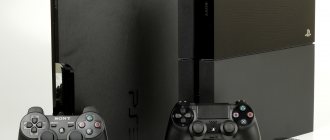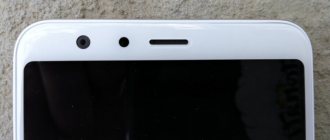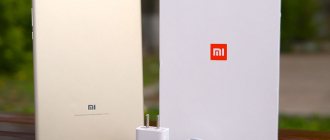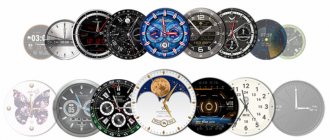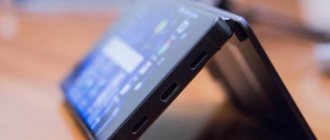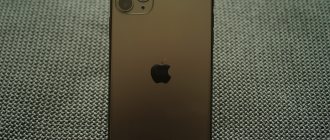In February 2020, Alcatel OneTouch announced that it was changing its name and logo. Now the company is simply called Alcatel. This quasi-rebranding was part of preparing the public for the emergence of something completely new. On February 23, at the MWC 2016 exhibition, the company introduced the Idol 4 and Idol 4S smartphones. Experts assessed the development extremely positively, as a result of which Alcatel was awarded 14 awards. In this review, we will look at the “younger of the brothers” (average price 17,490 rubles) Alcatel Idol 4 and find out why experts love it so much.
Telegram channel of the creator of Trashbox about technology
Specifications
- Screen: 5.2″, IPS, 16 million colors, 1920×1080 pixels, capacitive, NEG/Corning Gorilla glass, ColoRize color enhancer;
- Operating system: Android 6.0 Marshmallow;
- Processor: Qualcomm Snapdragon 617, Cortex-A53, 4 x 1.5 GHz + 4 x 1.2 GHz;
- GPU: Qualcomm Adreno 405, 550 MHz;
- RAM: 3 GB;
- Built-in memory: 16 GB, support for microSD memory cards up to 512 GB;
- Cameras: Main 13 MP – dual-tone flash, digital zoom, PDAF phase detection autofocus in 0.1 s,
- front 8 MP – LED flash, digital. zoom;
- Video recording: 1920 x 1080, 30 fps, EIS stabilization;
- Battery: Li-Ion 2610 mAh;
- Dimensions: 147.0 x 72.5 x 7.1 mm;
- Weight: 135 g;
- SIM slots: 2 nanoSIM/nanoSIM, Dual Standby;
- Communication: GSM: 850/900/1800/1900, 3G: HSPA+ 42Mb/s, UMTS: 850/900/1900/2100,
- LTE: Cat4 – B1/3/7/8/20/28A up to 150 Mbit/s, WIFI: 802.11 a/b/g/n/ac 2.4/5 GHz, Bluetooth 4.2, GPS (AGPS);
- Sensors: light, proximity, gyroscope, accelerometer, compass, Hall;
- Available colors: gray, silver, golden;
- Features: Flip-to-Mute, Wide Range Audio, Dual 3.6W Speakers, Waves Technology, TFA9890 Smart Power Amplifier, Onetouch Music.
Review of the Alcatel Idol 4 (6055K) Android smartphone: a dude with interesting features
Table of contents
- Introduction
- Specifications
- Packaging and equipment
- Appearance and design
- Display
- Hardware platform and performance
- Firmware and software
- Multimedia
- Memory and file system
- Wireless Interfaces and Communications
- Navigation
- Battery life
- Camera
- Comparison with competitors
- Conclusion
Introduction
The fate of the French company Alcatel has not been easy these days;
however, like many other European, American and even Japanese firms, faced with fierce competition from the rapidly developing Chinese electronics industry. Some were able to retain leading positions, such as Apple, while others retained only the brand name, such as Motorola. At the moment, Alcatel can be considered absorbed by Finnish Nokia (which, however, also had a difficult fate). However, the brand itself is alive, and sometimes very interesting smartphone models are produced under it.
Alcatel smartphones, like many other European, American and Russian brands, are manufactured at a Chinese production base. They are produced by the large Chinese company TCL, which also has part of the rights to the Alcatel brand in the field of mobile devices. That's how confusing everything is with this once purely French brand.
Thanks to our partner - the online store Bayon.ru, the hero of the review will be the Alcatel Idol 4 smartphone. It can be conditionally classified as the upper part of the middle price range. It implements several interesting ideas, both in terms of functionality and appearance.
announcements and advertising
2080 Super Gigabyte Gaming OC for 60 rubles.
Compeo.ru - the right comp store without any tricks
RTX 2060 becomes cheaper before the arrival of 3xxx
Ryzen 4000
series included in computers already in Citylink
The price of MSI RTX 2070 has collapsed after the announcement of RTX 3xxx
Core i9 10 series is half the price of the same 9 series
The price of memory has been halved in Regard - it’s more expensive everywhere
The official page of the smartphone is here. On the official page, the rear view of the smartphone in some images matches the real one, in others it does not. Probably a webmaster mistake.
Technical characteristics of Alcatel Idol 4
The model considered in the review has an “older brother” - Alcatel Idol 4S. On the one hand, it offers a similar appearance and “ideology” of operation, on the other, a more powerful hardware platform and a higher price.
| Model | Alcatel Idol 4 | Alcatel Idol 4S |
| CPU | Qualcomm Snapdragon 617, 64 bit, 8 cores (8 Cortex-A53 x 1.5 GHz) | Qualcomm Snapdragon 652, 64 bit, 8 cores (4 Cortex-A72 x 1.8 GHz + 4 Cortex-A53 x 1.4 GHz) |
| Video processor | Adreno 405 | Adreno 510 |
| operating system | Android 6.0 | Android 6.0 |
| RAM, GB | 3 | 3 |
| Flash memory | 16 | 32 |
| Screen (size, type, resolution) | 5.2″, IPS LPTS, 1920 x 1080 | 5.5″, AMOLED, 2560 x 1440 |
| Rear camera, Mpix | 13.0 (autofocus, flash) | 16.0 (autofocus, flash) |
| Front camera, Mpix | 8.0 (flash) | 8.0 (flash) |
| Number of SIM cards | 2 (nano SIM) | 2 (nano SIM) |
| MicroSD card support | Yes (combined SIM/SD-card slot) | Yes (combined SIM/SD-card slot) |
| Data transfer | GPRS/EDGE/3G/HSPA+/4G; Wi-Fi 802.11b/g/n/ac; NFC; Bluetooth 4.1 | GPRS/EDGE/3G/HSPA+/4G; Wi-Fi 802.11b/g/n/ac; NFC; Bluetooth 4.2 |
| Navigation | GPS/A-GPS/GLONASS/BDS | GPS/A-GPS/GLONASS/BDS |
| Interfaces | USB-OTG, 3.5 mm jack (headphones/headset) | USB-OTG, 3.5 mm jack (headphones/headset) |
| Additionally | FM radio | FM radio, virtual reality helmet |
| Battery, mAh | 2 610 (fixed) | 3,000 (fixed) |
| Dimensions, mm | 147.0 x 72.5 x 7.1 | 153.9 x 75.4 x 7.0 |
| Weight, g | 135 | 149 |
| price, rub. | ~19 000 | ~30 000 |
As you can see from the table, the closeness of our smartphone (Idol 4) and its “big brother” (Idol 4S) is more likely purely “ideological” than hardware. In terms of hardware, the “big brother” is significantly ahead of our hero in almost all indicators.
Let's start the “analysis” of our hero with the main component. The smartphone uses a “mid-class” Qualcomm Snapdragon 617 processor with eight Cortex-A53 cores operating at 1.5 GHz. But everything is fine with RAM - as much as 3 GB is installed, and this is a level used even in flagships.
The rear camera has average parameters for today, 13 megapixels. The front camera has parameters above average for such cameras, its resolution is 8 megapixels, and is additionally equipped with a flash. Regarding other devices, it should be added that the smartphone has a vibration motor, an automatic brightness adjustment sensor, an orientation sensor (G-sensor), proximity and a magnetometer.
The smartphone uses a rather ingenious solution: it does not have a separate notification LED, and the flash of the front camera acts as its flash, but, of course, not at full power. The smartphone runs Android 6.0.1 Marshmallow OS. The actual weight of the smartphone together with the SIM and memory card was 139 g, so the manufacturer’s data on this parameter can be considered confirmed.
And finally, we must say about the special appearance of the smartphone. The appearance gives the impression of an elite device. Perhaps only Samsung smartphones with curved display edges can make a stronger impression. Our hero has not only the front panel made of glass, but also the back panel. Real metal is used on the side edges. It also has a variety of speaker grilles. Why all this was done - we’ll figure it out further.
Packaging and equipment Alcatel Idol 4
The device is packaged in the traditional way: in the form of a thick cardboard box. The box is made in a combination of light and dark tones that attract the buyer's attention.
On the top of the box there is a dark golden holographic sticker informing the consumer that the device was awarded an award at the MWC 2016 exhibition (Mobile World Congress):
Brief technical information about the device is printed in small print on the side of the box:
There is a small error in the technical data. They indicate that some processor cores operate at a frequency of 1.5 GHz, and some at a frequency of 1.2 GHz. The official website of the processor manufacturer (Qualcomm) states that the frequency of all cores of the Snapdragon 617 processor is 1.5 GHz.
This is what the box looks like from a reverse angle:
On the bottom side of the box there is only legal information of little relevance to the consumer. In particular, it is indicated there (including in Russian) that the Alcatel trademark belongs to Alcatel-Lucent and is used by TCL (China) under license:
Now open the packaging (the protective bag has been removed from the smartphone):
Here we see a smartphone with a transport protective film glued to it. At the same time, it also plays an advertising and informational role.
Now let's look at the package. The set of accessories is sufficient, so we will study it in order. Let's start with the cable and charger:
The USB-microUSB cable is absolutely standard, like thousands of others. And the charger is more powerful than most of its “colleagues” - it produces a current of as much as 2 A at a voltage of 5 V.
The next part of the kit is the headset:
The headset is small-sized, plug-type, with a beautiful ribbon cable. The headset manufacturer is not the typical Chinese “Noname”, but the well-known and popular one – JBL. But, with all due respect to the manufacturer, it must be said frankly that there are no Hi-Fi headphones in the “plug” form factor.
The next group of components is a protective film for the screen, a bumper case and a “clip” for removing the tray with SIM cards:
The bumper case is made of transparent plastic, so its outline is not very visible in the photo. By the way, the plastic is hard, not soft (not silicone).
And finally, the last part of the kit, the “papers”:
From this set of pieces of paper, perhaps the warranty card is superfluous, since the smartphone, after turning it on, offers to register an electronic warranty. But since this “piece of paper” exists, then let it be, who knows...
Let's summarize the smartphone's equipment:
- The smartphone itself;
- Charger;
- USB-microUSB cable;
- Headset;
- User manual and three other paper documents;
- Protective film on the screen;
- Bumper case;
- Tray removal tool.
We can rate the package as very good. The only thing missing is a USB OTG adapter cable, since testing will show that the smartphone supports this mode.
Next, we move on to the main component of the kit – the smartphone.
Equipment
The original box is quite informative and contains the actual image of the smartphone, the Alcatel company logo, the main technical characteristics and outstanding features of Idol 4, including the “Boom” button, which expands the possibilities of using the gadget.
The reverse side contains legal information regarding the Alcatel trademark in different languages and images stating that the box is recyclable, warnings about the type of SIM cards used and preventing possible hearing damage.
Inside the box, in addition to the phone itself, there is a 5V 2A charger, a micro-USB cable for connecting to a PC, a “key” for accessing the SIM card and microSD slots, a warranty card, a “Getting Started” leaflet, a booklet with information about safety measures and warranty conditions, as well as a protective film on the screen and plastic protection for the back cover.
The set includes in-ear headphones from JBL, a company specializing in the production of acoustic audio equipment since 1946, and 4 spare tips of different sizes. The quality of the headset is made at a professional level and when used (not only with Idol 4) it provides excellent deep ultra-surround sound and unsurpassed sound quality. As standard, the headphones function as an antenna for listening to FM radio.
Appearance
The Alcatel Idol 4 case is made of metal with plastic inserts. The front and back surfaces are covered with glass.
Alcatel calls the Idol 4's design "symmetrical". This is so, because two speakers are located symmetrically at the top and bottom of the smartphone, and two microphones are located at the top and bottom ends on one side.
There are no touch buttons for “home”, “back” and “running applications” on the phone - they are integrated into the OS.
On the front panel above the screen there is a flash, which also serves as a light indicator when receiving calls and messages and while charging the battery, a company logo, a light sensor and a front camera. A little higher is the already mentioned speaker.
On the back surface in the corner there is a main camera with a dual flash. Above the center in the middle is the new Alcatel logo, shimmering with a spin effect, below is the Idol series brand and other standard technical symbols, which, fortunately, are barely noticeable and do not spoil the overall appearance of the device.
The bezels around the screen are quite thin. The absence of touch buttons made it possible to slightly reduce the size of the phone. Holding Alcatel Idol 4 in your hand is as comfortable as holding a smartphone with a 5.2″ screen.
On top are the 3.5mm jack and microphone.
At the bottom, symmetrically to the top, there is a second microphone and a micro-USB connector.
The manufacturer placed the power button on the left side.
On the right side there are volume control buttons, a “BOOM” key and a very well hidden compartment with slots for SIM cards and a microSD memory card.
⇡#Appearance and ergonomics
The new Alcatel Idol 4 series smartphones are woven according to the unwritten laws of mobile fashion - metal and glass. They end up looking really great. Actually, there are two of them, and they differ in screen sizes: Idol 4 is smaller - it has a 5.2-inch screen, Idol 4S is a little larger - it is equipped with a 5.5-inch display.
Alcatel Idol 4S – front panel
The device retains the “trick” of Idol 3 – reversibility. It doesn’t matter which side we take the device from, the information on the screen will be displayed in the desired orientation, even if we grab the smartphone upside down. Accordingly, the front panel of the gadget is almost symmetrical; there are no hardware keys on it.
Alcatel Idol 4S – earpiece speaker
Decorative speaker grids are located on both sides. Nevertheless, it is not difficult to figure out the upper part of the front panel - it contains the front camera lens, LED flash and LED event indicator.
Alcatel Idol 4S – side panel
The control logic of the Alcatel Idol 4S takes some getting used to. The fact is that on the right side, next to the volume control key, there is a small round button - just like the first smartphones of the Sony Xperia Z series. It would be absolutely logical to assume that this is the power/lock button of the device. But no, that was not the case! This is responsible for a number of contextual actions - depending on what application the user is working with. You can wake up the device with it, but you can’t block it. It happens that you want to turn off your gadget, but instead you look at a collage in a photo gallery or a weather animation.
| Alcatel Idol 4S – Boom key settings | |||
This key is associated with a number of proprietary software options, “built into” the Alcatel shell: for example, you can take a photo even if the smartphone is locked, or enhance the lower frequencies when listening to music. The Boom function is not determined by the user in the settings, but by the application that is currently open. It’s cool and unusual, but the placement of the hardware key itself is unfortunate.
| Alcatel Idol 4S – interface layout | ||
The device's power key is located on the left side, closer to the speaker. Its location is again non-standard - you have to reach with the index finger of your right hand. Why not place it, for example, on the top edge is not clear. Next to the power button is a slot for two SIM cards. The layout of the interfaces is standard: the audio jack is located on the top edge, the Micro-USB connector is on the bottom. There is no fingerprint scanner here – which is a pity, as it is precisely what is missing to fully identify the Idol 4S as a competitor to A-brand flagships.
Alcatel Idol 4S – rear panel
The “back” of the smartphone is covered with tempered glass – a beautiful solution, but not very practical. Firstly, the smartphone slips in wet hands. Secondly, the glass readily collects fingerprints - however, due to the oleophobic coating, it is easy to clean. The main camera lens protrudes above the glass, framed by a protective edge. Next to it is a two-color LED flash. There are no complaints about the assembly of the device.
Display
The gadget in question is equipped with a 5.2″ display with an IPS matrix displaying more than 16 million colors and a resolution of 1920x1080 pixels. Implemented ColoRize color enhancement technology. The screen, like the entire front surface, is covered with Gorilla Glass. The oleophobic coating is present and does its job well.
The color rendition is excellent. The automatic screen brightness mode is doubly convenient to use. Although in very bright light the image on the display is not very visible, I would even say nothing is visible at all. You will have to take photographs on the street blindly, then, covering them with your hand, try to see what happened.
Multitouch support - up to 5 touches are recognized, especially since the screen size easily allows this.
Iron
Alcatel Idol 4 runs on a Qualcomm Snapdragon 617 processor, with eight ARM Cortex-53 cores, four each at 1.5 GHz and 1.2 GHz.
The graphics are handled by Qualcomm Adreno 405 with a frequency of 550 MHz. The quality of textures and light is quite satisfactory, although the characteristic “ladder” is, of course, noticeable during the game.
The phone has two slots for the most modern nanoSIM format, but you can only use either two SIM cards, or one SIM card and a microSD card.
The device's RAM capacity is 3 GB. On average, only half of this number is used. The speed is good, applications launch quickly.
Of the 16 GB of internal memory, a little more than 10 GB is available to the user. Considering the potential scope of a smartphone and the associated need to store a large number of music tracks and Full HD videos (and also games of several gigabytes), we can conclude that microSD is actually a “must have” for Idol 4.
During intense load (for example, games), the smartphone begins to heat up very much.
Memory and speed
The Alcatel Idol 4 smartphone is powered by a Qualcomm Snapdragon 617 chip with an octa-core 1.7 GHz processor per core. The RAM capacity of 3 GB is pleasing. There is enough RAM for the device to operate quickly. The built-in flash memory is 16 GB, of which about 10 GB is available to the user. In addition, there is a slot for using microSD cards up to 512 GB. That's a plus.
If we talk about the perceived speed of the device, then it is very fast. I didn't notice any slowdown in the interfaces. Everything is clear and fast. Opening third-party applications occurs in 1-2 seconds. These are average performance indicators.
You can watch videos on your smartphone without any glitches. Pre-installed codecs allow you to play video in the popular .avi and .mkv formats, but not all audio codecs are supported. Watching videos from YouTube is carried out without delays or freezes, although this depends on your operator and mobile Internet. The smartphone also performed well in pre-installed games. Heavy games like GTA: Vice City, WoT Blitz, Asphalt 8, Godfire work without problems. True, the heating of the case is felt in the upper part of the case. Very decent for an affordable hardware platform.
Software
The smartphone runs on the Android 6.0 Marshmallow operating system. As is already customary for many, it served as the foundation for building a new system, and Alcatel, naturally, made some additions.
Having unlocked the phone, the user will see beautiful wallpapers that will change every time they are turned on and shaken, and a set of quick access icons. The number of photographs presented for the background is colossal. During the time the smartphone was being tested, I only came across the same picture a couple of times. However, everything is customized to suit the individual needs of the consumer.
The main screen wallpaper has a parallax effect: it moves when tilted, allowing you to “look beyond the boundaries” of the image.
One of the “features” of Idol 4 is the so-called “reversibility”, the meaning of which is the constant “correct” position of the phone. Thus, you can safely use your smartphone even when upside down.
The gadget is designed for listening to music. In this regard, Idol 4 has two applications: Onetouch Music and the Waves MaxxAudio audio effects processor.
The first application is an advanced audio player with a set of various DJ gadgets: mixing mode, samplebox mode and scratching.
Waves MaxxAudio is a powerful equalizer with fine-tuning capabilities and an impressive range of presets for watching videos and listening to music. There is an automatic mode. Waves does not work when BOOM mode is enabled.
Menu. Interface and navigation
Alcatel Idol 4 runs on Android 6.0.1 Marshmallow operating system. Android 6 here is almost stock: there is a main menu, and the settings, capabilities and everything else are almost no different from, say, Nexus smartphones. The only thing is that we have added our own themes and widgets. I will also note a large number of pre-installed applications.
There is AVG antivirus, WPS Office office suite, Xender - an application for offline data transfer via Wi-Fi protocol, Shazam music detector, Deezer music service, as many as four additional application stores (one of them contains virtual reality applications), a set popular instant messengers and social network clients, a set of applications from Google and much more. There are also games: Asphalt Overdrive, Lamper VR, a separate “Game Center”. The missing programs can be downloaded from Google Play.
I would like to note the rich multimedia capabilities of the device. The Waves MaxxAudio app acts as an equalizer. The sound can be customized for different use cases: music, movies, general sounds. There are quite a lot of settings, and considering that the smartphone’s speakers produce high-quality sound, I want to use these settings.
The sound in Idol 4 is provided by two powerful stereo speakers of 3.6 W each. They sound very loud and clear. At the software level, the sound is improved by special intelligent optimization technology from Waves Audio.
One of the nice bonuses is the presence of a built-in FM radio. In order for it to work, you need to connect headphones.
The “boom” button deserves special mention. It performs different actions in different programs and menus. If the smartphone is locked, one press will unlock the screen. Double tapping will turn on the camera and take a quick photo. A long press will take a whole photo series. While the camera is operating, the button is responsible for launching the TiZR application for broadcasting video in real time.
When watching movies and listening to music, the key expands the low frequency range and improves sound clarity. Interestingly, the BOOM key has integration with the game Asphalt Overdrive. When pressed, nitro is activated and the sound volume increases. Pressing a button can also launch a specific application, add a 3D effect to icons, or take a screenshot of the screen.
All this “interactivity” and “intellectuality” seemed extremely inconvenient and incomprehensible to me. It turns out that I, as a user, must remember what the button in application A, B, C, and so on is responsible for. Do you need this? I don't. And most of the owners too. It is better to configure this button for one, but necessary function. For example, launching the camera or unlocking the screen. It will be easier.
"BOOM" key!
But most of all the changes affected the shell in connection with equipping the gadget with a “magic” “BOOM” button. On the one hand, it's just another button on the device that can be programmed to take a screenshot, control the camera, or launch an application (or do nothing). But on the other, the best, main side is a wide range of possibilities in a wide variety of situations. The manufacturer presented a considerable number of so-called BOOM effects: controlling camera modes from the display off, turning on weather animation on the main screen, improving sound and increasing the volume while watching videos and listening to music, automatic collages from photos in the gallery, instant start of an online broadcast of what is being recorded videos, as well as applying fun video effects and special features during games.
If you press the “BOOM” button on the main screen, an animation of the current weather conditions will appear.
Specifications Alcatel One Touch Idol 4S 6070K
In terms of technical characteristics, the Alcatel Idol 4S 6070K is the top of the middle segment, with some features of a flagship.
Design, case materials, dimensions and weight
The device is made of premium materials: tempered glass on both sides, plus a metal base. In this regard, the appearance of the device is purely flagship. The dimensions of the device are 154x75 mm, which is quite average for a 5.5” phablet. The thickness of 7 mm and weight of 149 grams are pleasing, since this is noticeably less than the average in this standard size. The assembly is good, without cracks. The case is easily soiled, but stains can be easily wiped off with a lint-free cloth.
The front panel is 2.5D glass. There are no buttons under the screen, they are on-screen, but on the front panel there are symmetrical grids of stereo speakers (bottom and top).
The back panel of the smartphone is made symmetrically to the front. There are also speaker grids at the top and bottom, the glass in the corners does not reach the edges, and at the top in the middle there is a camera island with a flash. Some may not like the fact that it protrudes above the body, but knowing Chinese manufacturers, it’s better to have a normal camera that protrudes than a stripped-down module located flush. And the protruding lens should help a little from “collecting” scratches on the rear panel.
At the bottom end of the Alcatel Idol 4S 6070K there is a MicroUSB connector and a microphone hole.
On the top there are holes for the second microphone and a headset jack.
On the right side there is a sound control rocker and a “Boom” button (more about it later in the section about the operating system).
On the left side there is a card slot and a power/lock key.
Chipset
The Alcatel Idol 4S 6070K is powered by the Qualcomm Snapdragon 652 chipset. It is manufactured using a 28 nm process technology, has 4 Cortex A72 1.8 GHz cores and the same number of Cortex A53 1.4 GHz cores. 3D processing is handled by the Adreno 510 GPU.
The chipset demonstrates the performance of 2020 flagships, scoring about 80 thousand points in AnTuTu. However, in 2020, such an indicator is a sign of a good middle class, but not the top. The power is quite enough for work, there are no problems with toys either, but this year’s flagships show almost twice the performance.
The smartphone does not play YouTube videos at 50 or 60 frames per second in high definition. At this frequency, the maximum resolution of the reproduced image will be around 480p.
The smartphone gets noticeably warm under load. The maximum temperature in CPU-Z was recorded at 70 degrees. When playing games, the smartphone heats up to 45 degrees.
Memory
The RAM memory capacity is 3 GB. Of these, the system uses more than 1 GB, this figure is typical for modern smartphones at the beginning of 2020. This RAM capacity is also an attribute of the middle class rather than a flagship. The smartphone has 32 GB of internal memory, of which about 25 GB is free. There is a MicroSD slot, combined with a second SIM card slot.
Battery
The capacity of the non-removable battery of the Alcatel Idol 4S 6070K is 3000 mAh. The smartphone demonstrates battery life indicators that can be considered slightly more than average. It is enough for a day of active loads; in gentle mode the smartphone will last up to 2 days. You can watch a video from memory for a little more than 9 hours. In continuous play, the smartphone will last 3.5 hours.
Native charging supports QiuckCharge, with it the battery capacity is replenished to 100% in 1.5 hours.
Cameras
The main camera of the smartphone has a resolution of 16 MP, supports phase detection autofocus and is equipped with a dual-LED flash. Autofocus is slow, it's easier to tap on the screen. The camera uses a Sony Exmor RS IMX298 sensor. It has a 1/2.8” format and 1.12 micron pixels. The same sensor was used in 2020 flagships (Xiaomi Mi5, OnePlus 3 and 3T, Nubia Z11, Vivo Explay 5 and others), but the noise reduction in the Alcatel Idol 4S 6070K does not work well. If you zoom in on the sky in good lighting, noise will be visible. Also, the frame may become blurry at the edges. In average and poor lighting, there is a chance of getting a blurry shot.
The quality of shooting with the main camera of the smartphone, although not up to par with the Galaxy S7 or iPhone 7, can be called good. Level of detail, wide dynamic range (although not maximum), noise within normal limits. The smartphone noticeably retreats in front of the previously mentioned leaders only when shooting in poor conditions. Video recording is carried out in 4K with 30 FPS.
The front camera has a resolution of 8 MP, the aperture of the optics is f/2.4. It does not have autofocus, but it has a flash and supports FullHD video recording. Selfie quality is normal.
Here are some examples of pictures taken with the main camera:
Screen
Another flagship attribute of the Alcatel Idol 4S 6070K is the display. The smartphone is equipped with a 5.5-inch AMOLED matrix with a resolution of 2560x1440 pixels (like Samsung). This is not the latest version of the display (like the one used in the S7 Edge), but it is not a representative of the outdated generation either. Color rendition is not lame (which was typical of old AMOLEDs), the shades are saturated, but not “eye-popping”. The brightness is not very high, around 400 nits. The sensor supports up to 10 touches and has a good oleophobic coating.
When viewing viewing angles are examined in detail, the shades become slightly greenish when tilted.
Communications
A module that supports 2G GSM, 3G HSPA and 4G LTE is responsible for communication in the smartphone. It is compatible with LTE Band 3, 7, 8 and 20, so support for the latest generation European networks can be considered complete. There are two SIM cards, both Nano, but one slot is combined with a MicroSD card slot. Wi-Fi supports 2.4 and 5 GHz, the navigator works with GPS, BDS and GLONASS. There is also NFC on board.
The LTE smartphone handles well, but rarely switches to 3G.
Sound
The smartphone is equipped with a pair of stereo speakers located at the bottom and top. They are very loud and have a rich sound, although they do not reach the bass level of portable speakers or a boombox. Hi-Fi sound quality should be provided by two NXP TFA9890 amplifiers. For this purpose, Waves MaxxAudio software is preinstalled on board. There is a dedicated DAC for headphones - AKM4376.
The Alcatel Idol 4S 6070K comes with a JBL headset equipped with a remote control. In terms of level, it is much higher than most included smartphone headphones. The device sounds good, but the improvement program does not always really help; incorrect settings can even ruin the sound. Alcatel Idol 4S 6070K has FM radio. In general, the quality of good headphones will not disappoint.
operating system
The operating system of Alcatel Idol 4S 6070K is Android 6, almost clean, but not quite. The interface has undergone almost no changes, but functions have been added to work with the Boom button. It allows you to add bass and increase the volume when listening to music; take a screenshot; By pressing the button twice you will take an instant photo even if the smartphone is locked; enable weather animation on the main screen; apply various effects when watching videos; improve the quality of the speaker when talking in a noisy environment; create photo collages.
Features of Alcatel Idol 4S 6070K
The main feature of the Alcatel Idol 4S 6070K is the fact that the smartphone comes bundled with a VR headset. It is a kind of box located inside a regular cardboard package. These are not primitive Google CardBoards, but such a headset is far from the level of GearVR.
Another feature of the 6070K is that it is possible to activate a function that, depending on the position of the smartphone, can change the conversational microphone and speaker in places. The display image is flipped accordingly. No matter how you take your smartphone, it will never be upside down. You will be able to use it and talk on the phone - no matter how you take it out of your pocket.
Pros and cons of Alcatel Idol 4S 6070K
Pros:
- high-quality screen;
- decent sound in headphones;
- high-quality sound from an external speaker;
- premium case;
- good performance in games.
- good conversational speaker.
Minuses:
- no fingerprint scanner;
- overheating under load;
- Does not play video at 50 frames per second or higher.
Alternatives to Alcatel Idol 4S 6070K
Motorola Moto Z Play is a competitor without QHD and stereo, with a slightly weaker processor but more modern and energy efficient. It has a larger battery, better autonomy, module support and a lower price.
The Samsung Galaxy S7 Edge is a better flagship with a curved screen in all respects except stereo speakers, but is more expensive.
Huawei Nexus 6P is a 2020 flagship with a larger screen (also QHD), comparable hardware and about the same price.
HTC 10 is a flagship with stereo speakers, a good camera, but a smaller screen diagonal (5.2”).
Sound
Alcatel Idol 4 is equipped with two stereo speakers with a power of 3.6 W each. The maximum volume when the “BOOM” mode is on is almost 87 dB.
It also shows up here: the left and right audio channels switch places when turning. Another interesting feature is that the speaker design allows you to enjoy great sound even when the smartphone is facing down.
Our review of Alcatel Idol 4S 6070K
Alcatel Idol 4S 6070K is a smartphone of an unspecified category, combining the features of flagships and mid-range devices. As the review showed, he got the display, sound and design from the first ones. Although it is superior in sound to some of its top competitors. But from the middle level, the device inherited the processor and memory, as well as the camera, which not everyone will like. For such a price in 2020, it’s strange to see a device without a fingerprint sensor, do you really need one?
Images taken by Alexey Ignatiev.
Connection
Due to the fact that the top speaker is used during a conversation, the interlocutor can be heard very clearly, but as if from afar. Pressing the BOOM button increases the volume, which is very useful in noisy places.
There are no questions about the Wi-Fi module - the reception is quite strong even in conditions of weak signal propagation. The operation of the 4G module depends on the telecom operator, the hardware is fine.
The GPS works well. In 2 seconds, 14 satellites out of 30 “in view” began to follow the movement of the phone. However, when using the navigator, for some reason the phone was never able to determine the exact location along the entire route.
Communication capabilities
The device operates in 2G (850/900/1800/1900 MHz), 3G (850/900/1900/2100 MHz) and 4G (LTE band 800/1800/2600) networks. I didn’t notice any problems with reliable reception. The smartphone uses two nano-sized SIM cards. True, if you also use a memory card, the device will turn into a single-SIM one. One SIM card slot is combined with a memory slot.
In addition to mobile networks, the smartphone supports Bluetooth version 4.2 for file and voice transfer. There is also Wi-Fi IEEE 802.11 a/b/g/n (2.4 and 5 GHz). The device, of course, can be used as an access point or modem. In the settings, this item is listed as “Modem mode”. There is Wi-Fi Direct.
The smartphone has a navigator with support for GPS, A-GPS, BeiDou, GLONASS. “Cold” start – 5-6 minutes, “hot” – up to 15 seconds.
Camera
The main camera takes pictures with a resolution of 13 megapixels. Has a two-tone flash. The manufacturer states that the lens consists of 6 lenses. The camera is equipped with autofocus with ultra-fast face detection (0.1-0.3 s).
Available modes: automatic, slow motion, panorama, manual mode, microfilm shooting mode with the ability to edit in real time. There is a flicker suppression function.
The front camera shoots at 8 megapixels. Flicker reduction works here too.
Both cameras shoot video in Full HD 1920×1080 30 fps. There is EIS stabilization.
Slow motion shooting takes place in a resolution of 800x480. At the same time, the quality, to put it mildly, leaves much to be desired.
Results and conclusions
Alcatel Idol 4 is perfect for users whose life interests are entirely limited to listening and creating music and watching movies. The large screen will allow you to quickly navigate the Internet and comfortably enjoy watching your favorite video. Two powerful speakers and fine-tuned equalizer in the Waves app will give a group of friends an incredible amount of listening experience to their favorite music, and OneTouch Music will make anyone the king of the party. Headphones from JBL are a great way to abstract from reality in favor of a musical surround sound atmosphere. Photos and selfies taken using the gadget’s cameras will perfectly convey the moments of life, and the natural color rendition of the display will show them as brightly as possible. Various shooting modes will help you reveal your talent. The “BOOM” button will bring a lot of impressions to the process of using your smartphone.
Pros:
- Stylish design with glass
- Loud speakers
- Excellent sound quality
- BOOM button!
- Great headphones included
- Smartphone protection included
- Excellent color rendition of the display
- LTE support. Strong Wi-Fi
Minuses:
- Graphics are rather weak
- Video quality could be better
- Quiet speaker during a call
- Insufficient brightness with excess light.
Final score: 6 out of 10.





